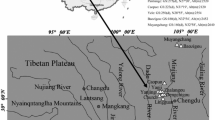Abstract
Using a life-table approach, pairs of exephippial sibs of Daphnia pulex were surveyed for sources of variation in life-history traits, and daphnids derived from diapausing and subitaneous eggs were assessed for differences in variance for these traits. Significant variation due to initial body length and sibs pair effect was observed in traits of exephippial females at the first adult instar (FAI). These results suggest higher environmental and genetic variability of life-history traits at the FAI in daphnids hatching from diapausing eggs than that in parthenogenetically derived ones. Exephippial females exhibited significantly higher variation in life-history properties at the FAI in response to various food levels, as well as within a high food treatment. The largest difference was found for the size of the first clutch and the body length of the juveniles produced in this clutch. Variance for relative fitness in females emerging from diapause was also higher than that for ones derived from subitaneous eggs.
Life-history strategies in exephippial Daphnia hatching during the early season are adapted to optimal conditions, whereas individuals of another origin are adapted to more unpredictable environments, and demonstrate bet-hedging strategies.
Similar content being viewed by others

References
Arbačiauskas, K., 1998. Life-history traits of exephippial and parthenogenetically derived daphnids: indicators of different life-history strategies. Arch. Hydrobiol. Beih. Ergebn. Limnol. 52: 339–358.
Arbačiauskas, K. & Z. R. Gasiūnaitė, 1996. Growth and fecundity of Daphnia after diapause and their impact on the development of a population. Hydrobiologia 320: 209–222.
Boersma, M., 1997a. Offspring size and parental fitness in Daphnia magna. Evol. Ecol. 11: 439–450.
Boersma, M., 1997b. Offspring size in Daphnia: does it pay to be overweight? Hydrobiologia 360: 79–88.
Boersma, M., H. Boriss & S. E. Mitchell, 2000. Maternal effects after sexual reproduction in Daphnia magna. J. Plankton Res. 22: 279–285.
Carvalho, G. R. & H. G. Wolf, 1989. Resting eggs of lake-Daphnia. I. Distribution, abundance and hatching of eggs collected from various depths in lake sediments. Freshwat. Biol. 22: 459–470.
De Meester, L., C. Cousyn & J. Vanoverbeke, 1998. Chemical interactions, maternal effects and the hatching of Daphnia diapausing eggs. Arch. Hydrobiol. Beih. Ergebn. Limnol. 52: 263–272.
De Meester, L. & H. De Jager, 1993. Hatching of Daphnia sexual eggs. 1. Intraspecific differences in the hatching response of D. magna eggs. Freshwat. Biol. 30: 219–226.
De Stasio, B. T., Jr., 1990. The role of dormancy and emergence patterns in the dynamics of a freshwater zooplankton community. Limnol. Oceanogr. 35: 1079–1090.
Ebert, D., 1993. The trade-off between offspring size and number in Daphnia magna: the influence of genetic, environmental and maternal effects. Arch. Hydrobiol. suppl. 90: 453–473.
Ebert, D., L. Yampolsky & S. C. Stearns, 1993. Genetics of life history in Daphnia magna. I. Heritabilities at two food levels. Heredity 70: 335–343.
Evans, A. S. & R. J. Cabin, 1995. Can dormancy affect the evolution of post-germination traits? The case of Lesquerella fendleri. Ecology 76: 344–356.
Hairston, N. G., Jr., 1998. Time travelers: What's timely in diapause research? Arch. Hydrobiol. Beih. Ergebn. Limnol. 52: 1–15.
Kleiven, O. T., P. Larsson & A. Hobæk, 1992. Sexual reproduction in Daphnia magna requires three stimuli. Oikos 65: 197–206.
Lampert, W., 1993. Phenotypic plasticity of the size at first reproduction in Daphnia: the importance of maternal size. Ecology 74: 1455–1466.
Lynch, M., 1984. The limits of life history evolution in Daphnia. Evolution 38: 465–482.
Lynch, M. & H.W. Deng, 1994. Genetic slippage in response to sex. Am. Nat. 144: 242–261.
Lynch, M. & R. Ennis, 1983. Resource availability, maternal effects and longevity. Exp. Geront. 18: 147–165.
Lynch, M., K. Spitze & T. J. Crease, 1989. The distribution of life history variation in the Daphnia pulex complex. Evolution 43: 1724–1736.
Pfrender, M. E. & H.-W. Deng, 1998. Environmental and genetic control of diapause termination in Daphnia. Arch. Hydrobiol. Beih. Ergebn. Limnol. 52: 237–251.
Rossi, V., L. Montesanto & P. Menozzi, 1998. Deposition season and hatching patterns of resting eggs in Mixodiaptomus kupelwieseri (Crustacea: Copepoda). Arch. Hydrobiol. Beih. Ergebn. Limnol. 52: 207–218.
Santer, B. & W. Lampert, 1995. Summer diapause in cyclopoid copepods: adaptive response to a food bottleneck? J. anim. Ecol. 64: 600–613.
Ślusarczyk, M., 1995. Predator-induced diapause in Daphnia. Ecology 76: 1008–1013.
Sokal, R. R. & F. J. Rohlf, 1995. Biometry, 3rd edn. W. H. Freeman and Company, New York.
Spitze, K., 1993. Population structure in Daphnia obtusa: quantitative genetic and allozymic variation. Genetics 135: 367–374.
Stross, R. G. & J. C. Hill, 1965. Diapause induction in Daphnia requires two stimuli. Science 150: 1462–1464.
Tessier, A. J., A. Young & M. Leibold, 1992. Population dynamics and body-size selection in Daphnia. Limnol. Oceanogr. 37: 1–13.
Van Dooren, T. I.M. & L. Brendonck, 1998. The hatching pattern of Brachipodopsis wolfi (Crustacea: Anostraca): phenotypic plasticity, additive genetic and maternal effects. Arch. Hidrobiol. Beih. Ergebn. Limnol. 52: 219–227.
Weber, A. & S. Declerck, 1997. Phenotypic plasticity of Daphnia life history traits in response to predator kairomones: genetic variability and evolutionary potential. Hydrobiologia 360: 89–99.
Weider, L. J., W. Lampert, M. Wessels, J. K. Colbourne & P. Limburg, 1997. Long-term genetic shifts in a microcrustacean egg bank associated with anthropogenic changes in the Lake Constance ecosystem. Proc. R. Soc. London B 264: 1613–1618.
Yampolsky, L. Y. & B. A. Kalabushkin, 1991. The components of life-history trait variation in a Daphnia magna population. Hydrobiologia 225: 255–261.
Author information
Authors and Affiliations
Rights and permissions
About this article
Cite this article
Arbačiauskas, K. Life-history variation related to the first adult instar in daphnids derived from diapausing and subitaneous eggs. Hydrobiologia 442, 157–164 (2001). https://doi.org/10.1023/A:1017593131383
Issue Date:
DOI: https://doi.org/10.1023/A:1017593131383



